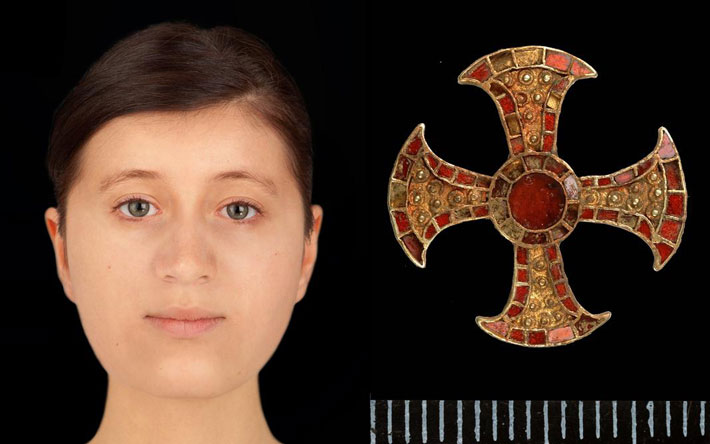 CAMBRIDGESHIRE, ENGLAND—According to a statement released by the University of Cambridge, the face of a young Anglo-Saxon woman whose remains were unearthed in 2012 in the East of England has been recreated by forensic artist Hew Morrison using measurements of her skull and tissue depth data for Caucasian females. Dated to the seventh century A.D., the remains were found on a carved wooden bed wearing gold and garnet pins that may have secured a long veil to a fine linen outer garment, and a gold and garnet cross, now known as the Trumpington Cross. Chemical analysis of her bones and teeth, conducted by Sam Legget, Alice Rose, and Emma Brownlee of the University of Cambridge, indicates that the young woman came to England sometime after the age of seven from somewhere near the Alps, perhaps southern Germany, where there was a bed burial tradition. Once she moved, the level of protein in her diet decreased. Similar isotopic analysis results have been found for two other women whose remains were found in bed burials in Cambridgeshire, Legget added. He thinks the elite women may have been political brides, or perhaps brides of Christ, in this early period of Christianity in England. “The fact that her diet changes once she arrived in England suggests that her lifestyle may have changed quite significantly,” he said. To read about opulent jewelry unearthed in a woman's grave in Northamptonshire, go to "Early Medieval Elegance."
CAMBRIDGESHIRE, ENGLAND—According to a statement released by the University of Cambridge, the face of a young Anglo-Saxon woman whose remains were unearthed in 2012 in the East of England has been recreated by forensic artist Hew Morrison using measurements of her skull and tissue depth data for Caucasian females. Dated to the seventh century A.D., the remains were found on a carved wooden bed wearing gold and garnet pins that may have secured a long veil to a fine linen outer garment, and a gold and garnet cross, now known as the Trumpington Cross. Chemical analysis of her bones and teeth, conducted by Sam Legget, Alice Rose, and Emma Brownlee of the University of Cambridge, indicates that the young woman came to England sometime after the age of seven from somewhere near the Alps, perhaps southern Germany, where there was a bed burial tradition. Once she moved, the level of protein in her diet decreased. Similar isotopic analysis results have been found for two other women whose remains were found in bed burials in Cambridgeshire, Legget added. He thinks the elite women may have been political brides, or perhaps brides of Christ, in this early period of Christianity in England. “The fact that her diet changes once she arrived in England suggests that her lifestyle may have changed quite significantly,” he said. To read about opulent jewelry unearthed in a woman's grave in Northamptonshire, go to "Early Medieval Elegance."
Elite Anglo-Saxon Woman’s Face Reconstructed
